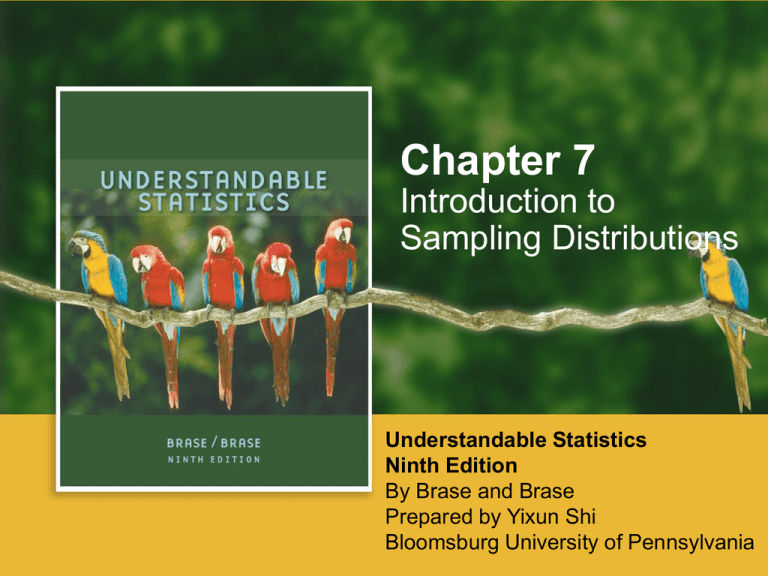
Chapter 7
Introduction to
Sampling Distributions
Understandable Statistics
Ninth Edition
By Brase and Brase
Prepared by Yixun Shi
Bloomsburg University of Pennsylvania
Terms, Statistics & Parameters
• Terms: Population, Sample, Parameter,
Statistics
Copyright © Houghton Mifflin Harcourt Publishing Company. All rights reserved.
7|2
Why Sample?
• At times, we’d like to know something about the
population, but because our time, resources,
and efforts are limited, we can take a sample to
learn about the population.
Copyright © Houghton Mifflin Harcourt Publishing Company. All rights reserved.
7|3
Types of Inference
1) Estimation: We estimate the value of a
population parameter.
2) Testing: We formulate a decision about a
population parameter.
3) Regression: We make predictions about the
value of a statistical variable.
Copyright © Houghton Mifflin Harcourt Publishing Company. All rights reserved.
7|4
Sampling Distributions
• To evaluate the reliability of our inference, we
need to know about the probability distribution
of the statistic we are using.
• Typically, we are interested in the sampling
distributions for sample means and sample
proportions.
Copyright © Houghton Mifflin Harcourt Publishing Company. All rights reserved.
7|5
The Central Limit Theorem (Normal)
• If x is a random variable with a normal
distribution, mean = µ, and standard deviation =
σ, then the following holds for any sample size:
Copyright © Houghton Mifflin Harcourt Publishing Company. All rights reserved.
7|6
The Standard Error
• The standard error is just another name for the
standard deviation of the sampling distribution.
Copyright © Houghton Mifflin Harcourt Publishing Company. All rights reserved.
7|7
The Central Limit Theorem
(Any Distribution)
• If a random variable has any distribution with
mean = µ and standard deviation = σ, the
sampling distribution of x will approach a
normal distribution with mean = µ and standard
deviation = n as n increases without limit.
Copyright © Houghton Mifflin Harcourt Publishing Company. All rights reserved.
7|8
Sample Size Considerations
• For the Central Limit Theorem (CLT) to be
applicable:
– If the x distribution is symmetric or
reasonably symmetric, n ≥ 30 should suffice.
– If the x distribution is highly skewed or
unusual, even larger sample sizes will be
required.
– If possible, make a graph to visualize how
the sampling distribution is behaving.
Copyright © Houghton Mifflin Harcourt Publishing Company. All rights reserved.
7|9
Critical Thinking
• Bias – A sample statistic is unbiased if the
mean of its sampling distribution equals the
value of the parameter being estimated.
• Variability – The spread of the sampling
distribution indicates the variability of the
statistic.
Copyright © Houghton Mifflin Harcourt Publishing Company. All rights reserved.
7 | 10
Sampling Distributions for Proportions pˆ r
n
• If np > 5 and nq > 5, then pˆ can be
approximated by a normal variable with mean
and standard deviation pˆ p
and
pq
pˆ
n
Copyright © Houghton Mifflin Harcourt Publishing Company. All rights reserved.
7 | 11
Continuity Corrections
• Since pˆ is discrete, but x is continuous, we
have to make a continuity correction.
• For small n, the correction is meaningful.
Copyright © Houghton Mifflin Harcourt Publishing Company. All rights reserved.
7 | 12
Control Charts for Proportions
• Used to examine an attribute or quality of an
observation (rather than a measurement).
• We select a fixed sample size, n, at fixed time
intervals, and determine the sample proportions
at each interval.
• We then use the normal approximation of the
sample proportion to determine the control
limits.
Copyright © Houghton Mifflin Harcourt Publishing Company. All rights reserved.
7 | 13
P-Chart Example
Copyright © Houghton Mifflin Harcourt Publishing Company. All rights reserved.
7 | 14












